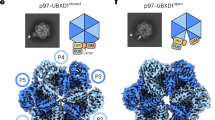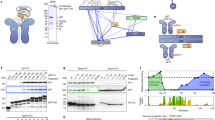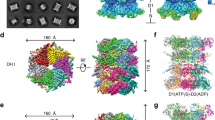Abstract
The ATPase p97/VCP affects multiple events within the cell. These events include the alteration of both nuclear and mitotic Golgi membranes, the dislocation of ubiquitylated proteins from the endoplasmic reticulum and regulation of the NF-κb pathway. Here we present the crystal structure of full-length Mus musculus p97/VCP in complex with a mixture of ADP and ADP–AlFx at a resolution of 4.7 Å. This is the first complete hexameric structure of a protein containing tandem AAA (ATPases associated with a variety of cellular activities) domains. Comparison of the crystal structure and cryo-electron microscopy (EM) reconstructions reveals large conformational changes in the helical subdomains during the hydrolysis cycle. Structural and functional data imply a communication mechanism between the AAA domains. A Zn2+ occludes the central pore of the hexamer, suggesting that substrate does not thread through the pore of the molecule.
This is a preview of subscription content, access via your institution
Access options
Subscribe to this journal
Receive 12 print issues and online access
$189.00 per year
only $15.75 per issue
Buy this article
- Purchase on Springer Link
- Instant access to full article PDF
Prices may be subject to local taxes which are calculated during checkout





Similar content being viewed by others
Accession codes
References
Hetzer, M. et al. Distinct AAA-ATPase p97 complexes function in discrete steps of nuclear assembly. Nat. Cell Biol. 3, 1086–1091 (2001).
Rabouille, C., Levine, T.P., Peters, J.M. & Warren, G. An NSF-like ATPase, p97, and NSF mediate cisternal regrowth from mitotic Golgi fragments. Cell 82, 905–914 (1995).
Ye, Y., Meyer, H.H. & Rapoport, T.A. The AAA ATPase Cdc48/p97 and its partners transport proteins from the ER into the cytosol. Nature 414, 652–656 (2001).
Rabinovich, E., Kerem, A., Frohlich, K.U., Diamant, N. & Bar-Nun, S. AAA-ATPase p97/Cdc48p, a cytosolic chaperone required for endoplasmic reticulum-associated protein degradation. Mol. Cell. Biol. 22, 626–634 (2002).
Braun, S., Matuschewski, K., Rape, M., Thoms, S. & Jentsch, S. Role of the ubiquitin-selective CDC48(UFD1/NPL4)chaperone (segregase) in ERAD of OLE1 and other substrates. EMBO J. 21, 615–621 (2002).
Asai, T. et al. VCP (p97) regulates NF-κB signaling pathway, which is important for metastasis of osteosarcoma cell line. Jpn. J. Cancer Res. 93, 296–304 (2002).
Kondo, H. et al. p47 is a cofactor for p97-mediated membrane fusion. Nature 388, 75–78 (1997).
Uchiyama, K. et al. VCIP135, a novel essential factor for p97/p47-mediated membrane fusion, is required for Golgi and ER assembly in vivo. J. Cell Biol. 159, 855–866 (2002).
Meyer, H.H., Wang, Y. & Warren, G. Direct binding of ubiquitin conjugates by the mammalian p97 adaptor complexes, p47 and Ufd1-Npl4. EMBO J. 21, 5645–5652 (2002).
Nagahama, M. et al. SVIP is a novel VCP/p97-interacting protein whose expression causes cell vacuolation. Mol. Biol. Cell 14, 262–273 (2003).
Hirabayashi, M. et al. VCP/p97 in abnormal protein aggregates, cytoplasmic vacuoles, and cell death, phenotypes relevant to neurodegeneration. Cell Death Differ. 8, 977–984 (2001).
Higashiyama, H. et al. Identification of ter94, Drosophila VCP, as a modulator of polyglutamine-induced neurodegeneration. Cell Death Differ. 9, 264–273 (2002).
Mizuno, Y., Hori, S., Kakizuka, A. & Okamoto, K. Vacuole-creating protein in neurodegenerative diseases in humans. Neurosci. Lett. 343, 77–80 (2003).
Frohlich, K.U. et al. Yeast cell cycle protein CDC48p shows full-length homology to the mammalian protein VCP and is a member of a protein family involved in secretion, peroxisome formation, and gene expression. J. Cell Biol. 114, 443–453 (1991).
Lamb, J.R., Fu, V., Wirtz, E. & Bangs, J.D. Functional analysis of the trypanosomal AAA protein TbVCP with trans-dominant ATP hydrolysis mutants. J. Biol. Chem. 276, 21512–21520 (2001).
Feiler, H.S. et al. The higher plant Arabidopsis thaliana encodes a functional CDC48 homolog which is highly expressed in dividing and expanding cells. EMBO J. 14, 5626–5637 (1995).
Tagaya, M., Wilson, D.W., Brunner, M., Arango, N. & Rothman, J.E. Domain structure of an N-ethylmaleimide-sensitive fusion protein involved in vesicular transport. J. Biol. Chem. 268, 2662–2666 (1993).
Malhotra, V., Orci, L., Glick, B.S., Block, M.R. & Rothman, J.E. Role of an N-ethylmaleimide-sensitive transport component in promoting fusion of transport vesicles with cisternae of the Golgi stack. Cell 54, 221–227 (1988).
Rockel, B. et al. Structure of VAT, a CDC48/p97 ATPase homolog from the archaeon Thermoplasma acidophilum as studied by electron tomography. FEBS Lett. 451, 27–32 (1999).
Yu, R.C., Jahn, R. & Brunger, A.T. NSF N-terminal domain crystal structure: models of NSF function. Mol. Cell 4, 97–107 (1999).
Yu, R.C., Hanson, P.I., Jahn, R. & Brunger, A.T. Structure of the ATP-dependent oligomerization domain of N-ethylmaleimide sensitive factor complexed with ATP. Nat. Struct. Biol. 5, 803–811 (1998).
May, A.P., Misura, K.M., Whiteheart, S.W. & Weis, W.I. Crystal structure of the amino-terminal domain of N-ethylmaleimide-sensitive fusion protein. Nat. Cell Biol. 1, 175–182 (1999).
Lenzen, C.U., Steinmann, D., Whiteheart, S.W. & Weis, W.I. Crystal structure of the hexamerization domain of N-ethylmaleimide-sensitive fusion protein. Cell 94, 525–536 (1998).
Coles, M. et al. The solution structure of VAT-N reveals a 'missing link' in the evolution of complex enzymes from a simple βαββ element. Curr. Biol. 9, 1158–1168 (1999).
Babor, S.M. & Fass, D. Crystal structure of the Sec18p N-terminal domain. Proc. Natl. Acad. Sci. USA 96, 14759–14764 (1999).
Zhang, X. et al. Structure of the AAA ATPase p97. Mol. Cell 6, 1473–1484 (2000).
Rouiller, I. et al. Conformational changes of the multifunction p97 AAA ATPase during its ATPase cycle. Nat. Struct. Biol. 9, 950–957 (2002).
Rockel, B., Jakana, J., Chiu, W. & Baumeister, W. Electron cryo-microscopy of VAT, the archaeal p97/CDC48 homolog from Thermoplasma acidophilum. J. Mol. Biol. 317, 673–681 (2002).
Guo, F., Maurizi, M.R., Esser, L. & Xia, D. Crystal structure of ClpA, an Hsp100 chaperone and regulator of ClpAP protease. J. Biol. Chem. 277, 46743–46752.
Beuron, F. et al. Motions and negative cooperativity between p97 domains revealed by cryo-electron microscopy and quantised elastic deformational model. J. Mol. Biol. 327, 619–629 (2003).
Song, C., Wang, Q. & Li, C.C. ATPase activity of p97-valosin-containing protein (VCP). D2 mediates the major enzyme activity, and D1 contributes to the heat-induced activity. J. Biol. Chem. 278, 3648–3655 (2003).
Wang, Q., Song, C. & Li, C.C. Hexamerization of p97-VCP is promoted by ATP binding to the D1 domain and required for ATPase and biological activities. Biochem. Biophys. Res. Commun. 300, 253–260 (2003).
Neuwald, A.F., Aravind, L., Spouge, J.L. & Koonin, E.V. AAA+: a class of chaperone-like ATPases associated with the assembly, operation, and disassembly of protein complexes. Genome Res. 9, 27–43 (1999).
Benaroudj, N., Zwickl, P., Seemuller, E., Baumeister, W. & Goldberg, A.L. ATP hydrolysis by the proteasome regulatory complex PAN serves multiple functions in protein degradation. Mol. Cell 11, 69–78 (2003).
Beyer, A. Sequence analysis of the AAA protein family. Protein Sci. 6, 2043–2058 (1997).
Otwinowski, Z. & Minor, W. Processing of X-ray diffraction data collected in oscillation mode. Methods Enzymol. 276, 307–326 (1997).
Collaborative Computational Project, Number 4. The CCP4 suite: programs for protein crystallography. Acta Crystallogr. D 50, 760–763 (1994).
Bass, R.B., Strop, P., Barclay, M. & Rees, D.C. Crystal structure of Escherichia coli MscS, a voltage-modulated and mechanosensitive channel. Science 298, 1582–1587 (2002).
Pannu, N.S., Murshudov, G.N., Dodson, E.J. & Read, R.J. Incorporation of prior phase information strengthens maximum-likelihood structure refinement. Acta Crystallogr. D 54, 1285–1294 (1998).
Jiang, J.S. & Brunger, A.T. Protein hydration observed by X-ray diffraction. Solvation properties of penicillopepsin and neuraminidase crystal structures. J. Mol. Biol. 243, 100–115 (1994).
Brunger, A.T. et al. Crystallography & NMR system: a new software suite for macromolecular structure determination. Acta Crystallogr. D 54, 905–921 (1998).
Jones, T.A., Zou, J.Y., Cowan, S.W. & Kjeldgaard . Improved methods for building protein models in electron density maps and the location of errors in these models. Acta Crystallogr. A 47, 110–119 (1991).
Schlichting, I. & Reinstein, J. pH influences fluoride coordination number of the AlFx phosphoryl transfer transition state analog. Nat. Struct. Biol. 6, 721–723 (1999).
Braig, K., Adams, P.D. & Brunger, A.T. Conformational variability in the refined structure of the chaperonin GroEL at 2.8 Å resolution. Nat. Struct. Biol. 2, 1083–1094 (1995).
Indyk, L. & Fisher, H.F. Theoretical aspects of isothermal titration calorimetry. Methods Enzymol. 295, 350–364 (1998).
Laskowski, R.A., MacArthur, M.W., Moss, D.S. & Thornton, J.M. PROCHECK: a program to check the stereochemical quality of protein structures. J. Appl. Crystallogr. 24, 946–950 (1993).
Acknowledgements
We thank G. Warren for supplying the initial p97/VCP clones, P. Adams, C. Chaudhry, I. Rouiller, P. Strop, W. Weis and L. Wilson-Kubalek for stimulating discussions, A. Joachimiak for generous access to beamline ID-19 at Advanced Photon Source, M. Boulanger for expert assistance with ITC experiments and C. Garcia for generous access to ITC equipment, E. Gabriel for assistance with crystal production and A. May and N. Gassner for a critical reading of the manuscript. Portions of this research were carried out at the Stanford Synchrotron Radiation Laboratory (SSRL), a national user facility operated by Stanford University on behalf of the US Department of Energy, Office of Basic Energy Sciences. The SSRL Structural Molecular Biology Program is supported by the Department of Energy, Office of Biological and Environmental Research, and by the US National Institutes of Health, National Center for Research Resources, Biomedical Technology Program, and the National Institute of General Medical Sciences.
Author information
Authors and Affiliations
Corresponding author
Ethics declarations
Competing interests
The authors declare no competing financial interests.
Supplementary information
Rights and permissions
About this article
Cite this article
DeLaBarre, B., Brunger, A. Complete structure of p97/valosin-containing protein reveals communication between nucleotide domains. Nat Struct Mol Biol 10, 856–863 (2003). https://doi.org/10.1038/nsb972
Received:
Accepted:
Published:
Issue Date:
DOI: https://doi.org/10.1038/nsb972
This article is cited by
-
ASPSCR1-TFE3 reprograms transcription by organizing enhancer loops around hexameric VCP/p97
Nature Communications (2024)
-
Valosin containing protein (VCP): initiator, modifier, and potential drug target for neurodegenerative diseases
Molecular Neurodegeneration (2023)
-
Mechanisms of substrate processing during ER-associated protein degradation
Nature Reviews Molecular Cell Biology (2023)
-
Valosin-containing protein (VCP/p97) inhibition reduces viral clearance and induces toxicity associated with muscular damage
Cell Death & Disease (2022)
-
Compounds activating VCP D1 ATPase enhance both autophagic and proteasomal neurotoxic protein clearance
Nature Communications (2022)



